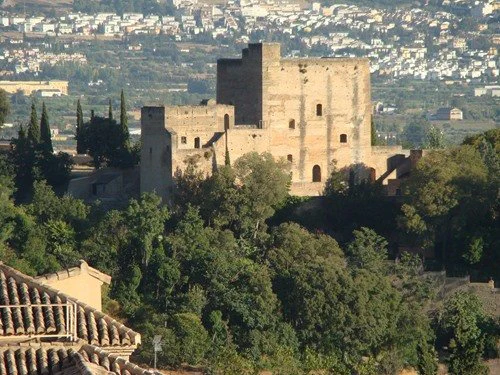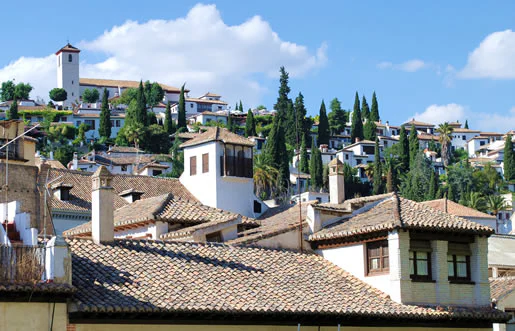The Torres Bermejas stand on the Mauror hill, directly facing the monumental complex of the Alhambra and Generalife. They consist of three towers that once formed part of the fortress Hizn Mawror, which stood along the eastern wall of the new city of Muslim Granada.
They were strategically built to oversee the city, the fertile plain stretching southwards, and the Alcazaba de la Alhambra to the north. From the Torres Bermejas, visitors can enjoy a sweeping panoramic view of Granada, visually connected to several towers of the Alhambra, especially the Torre de la Vela.
The complex was constructed using rammed earth. The central tower is the most prominent, featuring a curved bastion added during the Christian period. Beneath this bastion lies a cistern. The entrance gate, with its characteristic horseshoe arches, is located between the left and central towers. The central tower has three floors, the left one has two, and the right one only a single level.
Inside the walls, a considerable number of slabs from Muslim burials have been preserved, further highlighting the significant restoration work carried out on the Torres Bermejas after the arrival of the Catholic Monarchs in Granada.
History of the Torres Bermejas
The history of the Torres Bermejas is closely linked to that of the Alcazaba of the Alhambra. They formed part of Granada’s earliest defensive system, with their oldest remains dating from the late 8th and early 9th centuries. Historical records indicate the existence of a fortress predating the Alhambra, similar in nature to its Alcazaba, which served as one of the first defensive structures of ancient Garnata. This fortress was connected to the city wall where the Puerta de las Granadas stands today, and on the other side, to the wall descending towards the city centre. By the 11th century, the Torres Bermejas had been linked to the city’s defensive wall and to the Alcazaba of the Alhambra through a rampart, parts of which still survive. Under the Nasrid dynasty (13th century), the towers underwent significant modifications, first by Muhammad I Al-Ahmar and later by his son, Muhammad II.
After the fall of the Nasrid Kingdom, the towers were renovated in the 16th century and restored again between 1854 and 1858. Over the centuries, the Torres Bermejas served a variety of purposes, functioning at different times as barracks, a military prison, and even housing. Before becoming a military prison, they were converted into a men’s prison, a women’s prison, a detention centre for beggars, a shelter, and later a place of refuge. In 1962, they were acquired by the Patronato de la Alhambra y Generalife.
The site has undergone further restoration work in recent decades, the most recent being the intervention launched in 2018 prior to their reopening to the public. During this project, remains of the medieval wall were uncovered, along with parts of a Nasrid rammed-earth tower that the Catholic Monarchs modified in 1497, and the defensive system linking this fortress with the Torre del Homenaje was identified.
Visiting the Torres Bermejas
The Torres Bermejas can be visited on Saturdays and Sundays. Their opening hours follow the same schedule as the other visitable areas within the Monumental Complex of the Alhambra and Generalife:
- From 15 October to 31 March: 8:30 to 18:00.
- From 1 April to 14 October: 8:30 to 20:00.
Admission is free.
Inside, visitors can watch a video paying tribute to the restoration team of the Patronato de la Alhambra y Generalife. Created with the collaboration of Cervezas Alhambra, the video highlights the conservation and restoration work carried out in the workshops of the Monumental Complex. It focuses on the finer details and reveals some of the curiosities behind the team’s craftsmanship, while also guiding visitors through the unique character of this historic space.
How to Get to the Torres Bermejas
On foot
One of the easiest ways to reach the Torres Bermejas is on foot, as they lie very close to the Cuesta de Gomérez and the Realejo neighbourhood. From Plaza Nueva, for instance, the walk takes just about eleven minutes.
By car
It is possible to reach the Torres Bermejas by car, although parking can be challenging. One option is to park at the Alhambra car park and walk along the Paseo de la Sabica for roughly 23 minutes.
By bus or taxi
From the centre of Granada, you can take a bus that stops very close to the Torres Bermejas. Specifically, from the Plaza Isabel la Católica 4 stop, buses C30, C32 and C35 depart. You can get off at the Auditorio Manuel de Falla – Carmen de los Mártires stop and walk for about six minutes.
You can also reach the site by taxi, with the fare depending on the chosen route and the time of day.



